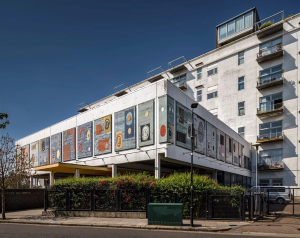 Twenty-nine abstract decorative panels by celebrated artist John Piper in Fulham, London have been listed at Grade II (GII), along with the former exhibition building to which they are attached.
Twenty-nine abstract decorative panels by celebrated artist John Piper in Fulham, London have been listed at Grade II (GII), along with the former exhibition building to which they are attached.
image: c HE Archive
… Piper building, was built for the Gas Board in the late 1950s…
Historic England writes:
The colourful fibreglass panels were commissioned to cover three sides of the exhibition block of the North Thames Gas Board headquarters on Peterborough Road.
The panels occupy a total area of approximately 250m² making them one of John Piper’s largest single commissions, thought to be second only to his Baptistry window at Coventry Cathedral.
Perhaps best known for his paintings, Piper also worked with skilled craftspeople to fulfil many public and applied arts commissions.
The main headquarters building, now known as the Piper building, was built for the Gas Board in the late 1950s but converted to residential and other uses in the 1990s – it is not included in the listing. The former exhibition block now serves as the main entrance to the Piper building.
The listing has been welcomed by the Twentieth Century Society, and follows an application made with support from architect Stephen Levrant RIBA.
The listing provides enhanced protection to the panels and former exhibition block and celebrates their artistic and architectural merit as well as their historic significance.
“From painter and official war artist to printmaker and stained glass designer, John Piper was a major figure in 20th century British art with an extraordinary breadth of work. These panels exemplify Piper’s continual experimentation with new materials and are a joyful, much-loved local landmark that meets the high bar for listing.”
Tom Foxall, Head of Region
Historic England
Piper collaborated with Gillespie and Manzaroli Associates to produce the panels between 1961-62. They have the hand-made appearance of paper cut-outs but made to an architectural scale in industrial materials. This commission was Piper’s first time working with fibreglass.
The panels are attached to the former exhibition block, a two-storey white-rendered building, which originally housed conference rooms and an exhibition space raised on slim columns (piloti) above an entrance hall and an industrial showroom beneath. The panels are the only known example of a permanent outdoor artwork in John Piper’s large and diverse body of work, and the building is integral to the way in which the artwork is encountered and perceived.
Post-war public art
The Piper panels fit into a wider trend of outdoor art at the time. The years following the Second World War saw a rise in the creation of public art, designed to bring public spaces back to life as the country began to repair its shattered towns and cities.
This idea was brought to a wide audience through the Festival of Britain in 1951. Visitors to the Festival saw around 30 sculptures and more than 100 murals integrated into the buildings and spaces of the South Bank site, commissioned from artists including John Piper. New or alternative materials such as concrete, mosaic and fibreglass were popular as they lent themselves to texture and relief and could withstand the elements.

